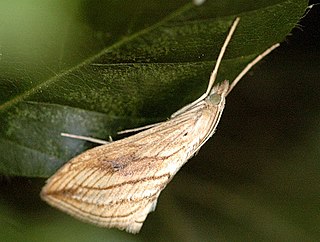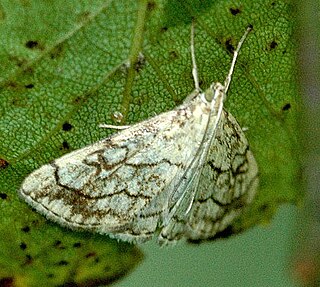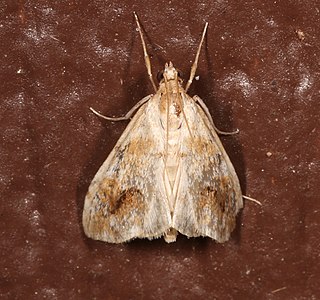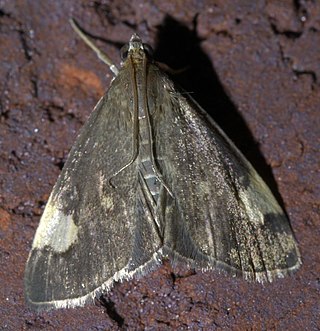
Evergestis forficalis, the garden pebble, is a species of moth of the family Crambidae. It is found in Europe, the Palearctic and North America. The species was described by Carl Linnaeus in his 1758 10th edition of Systema Naturae

Evergestis pallidata is a species of moth of the family Crambidae described by Johann Siegfried Hufnagel in 1811. It is found in Europe, across the Palearctic and in North America.

Evergestis is a genus of moths of the family Crambidae described by Jacob Hübner in 1825. A number of species are pests, including the cross-striped cabbageworm, a pest of cole crops such as cabbage.

Evergestis frumentalis is a moth of the family Crambidae. It is found from the Iberian Peninsula through southern and central Europe and southern Fennoscandia to central Asia and southern Siberia. The species was first described by Carl Linnaeus in 1761.
Evergestis angustalis is a moth in the family Crambidae. It was described by William Barnes and James Halliday McDunnough in 1918. It is found in North America, where it has been recorded from California and Arizona.
Evergestis aridalis is a moth in the family Crambidae. It was described by William Barnes and James Halliday McDunnough in 1914. It is found in North America, where it has been recorded from California and Nevada.
Evergestis borregalis is a moth in the family Crambidae. It was described by Eugene G. Munroe in 1974. It is found in North America, where it has been recorded from California and New Mexico.
Evergestis comstocki is a moth in the family Crambidae. It was described by Eugene G. Munroe in 1974. It is found in North America, where it has been recorded in California and Oregon.
Evergestis eurekalis is a moth in the family Crambidae. It was described by William Barnes and James Halliday McDunnough in 1914. It is found in North America, where it has been recorded from Arizona, California and Utah.
Evergestis funalis is a moth in the family Crambidae. It was described by Augustus Radcliffe Grote in 1878. It is found in North America, where it has been recorded from Alaska, Arizona, British Columbia, California, Colorado, Nevada, Oregon, Utah and Washington.

Evergestis lunulalis is a moth in the family Crambidae. It was described by William Barnes and James Halliday McDunnough in 1914. It is found in North America, where it has been recorded from Arizona, New Mexico and Texas.
Evergestis obliqualis is a moth in the family Crambidae. It was described by Augustus Radcliffe Grote in 1883. It is found in North America, where it has been recorded from Arizona, California, Colorado, New Mexico, Texas and Utah.
Evergestis palousalis is a moth in the family Crambidae. It was described by Eugene G. Munroe in 1974. It is found in North America, where it has been recorded from Alberta, British Columbia, California, Colorado, Nevada, Oregon and Utah.
Evergestis simulatilis is a moth in the family Crambidae. It was described by Augustus Radcliffe Grote in 1880. It is found in North America, where it has been recorded from Alberta, Arizona, British Columbia, California, Colorado, Montana, Nevada and New Mexico.
Evergestis subterminalis is a moth in the family Crambidae. It was described by William Barnes and James Halliday McDunnough in 1914. It is found in western North America, where it has been recorded from west central Alberta south to Colorado, Utah and California. The habitat consists of montane meadows.
Evergestis triangulalis is a moth in the family Crambidae. It was described by William Barnes and James Halliday McDunnough in 1914. It is found in North America, where it has been recorded from Arizona, Nevada and New Mexico.

Evergestis unimacula, the large-spotted evergestis moth, is a moth in the family Crambidae. It was described by Augustus Radcliffe Grote and Coleman Townsend Robinson in 1867. It is found in North America, where it has been recorded from Georgia, Illinois, Indiana, Iowa, Maryland, Michigan, North Carolina, Ohio, Oklahoma, Ontario, Pennsylvania, Quebec, Tennessee and West Virginia. Outliers have been recorded from Florida.
Evergestis vinctalis is a moth in the family Crambidae. It was described by William Barnes and James Halliday McDunnough in 1914. It is found in North America, where it has been recorded from Alberta, Arizona, British Columbia, California, Colorado, Kansas, Montana, Nevada, New Mexico, Texas and Wyoming.
Evergestis dischematalis is a moth in the family Crambidae. It is found in North America, where it has been recorded from Arizona and New Mexico.





